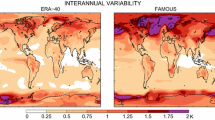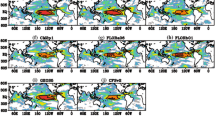Abstract
A problem for climate change studies with coupled ocean-atmosphere models has been how to incorporate observed initial conditions into the ocean, which holds most of the `memory' of anthropogenic forcing effects. The first difficulty is the lack of comprehensive three-dimensional observations of the current ocean temperature (T) and salinity (S) fields to initialize to. The second problem is that directly imposing observed T and S fields into the model results in rapid drift back to the model climatology, with the corresponding loss of the observed information. Anthropogenic forcing scenarios therefore typically initialize future runs by starting with pre-industrial conditions. However, if the future climate depends on the details of the present climate, then initializing the model to observations may provide more accurate forecasts. Also, this ∼ 130 yr spin up imposes substantial overhead if only a few decades of predictions are desired. A new technique to address these problems is presented. In lieu of observed T and S, assimilated ocean data were used. To reduce model drift, an anomaly coupling scheme was devised. This consists of letting the model's climatological (pre-industrial) oceanic and atmospheric heat contents and transports balance each other, while adding on the (much smaller) changes in heat content since the pre-industrial era as anomalies. The result is model drift of no more than 0.2 K over 50 years, significantly smaller than the forced response of 1.0 K. An ensemble of runs with these assimilated initial conditions is then compared to a set spun up from pre-industrial conditions. No systematic differences were found, i.e., the model simulation of the ocean temperature structure in the late 1990s is statistically indistinguishable from the assimilated observations. However, a model with a worse representation of the late 20th century climate might show significant differences if initialized in this way.
Similar content being viewed by others
References
Adcroft, A., Hill, C., and Marshall, J.: 1997, ‘Representation of Topography by Shaved Cells in a Height Coordinate Ocean Model’, Mon. Wea. Rev. 125, 2293–315.
Barnett, T. P., Malone, R., Pennell, W., Stammer, D., Semtner, A., and Washington, W.: 2004, ‘The Effects of Climate Change on Water Resources in the West: Introduction and Overview’, Clim. Change 62, 1–11.
Barnett, T. P., Pierce, D. W., and Schnur, R.: 2001, ‘Detection of Anthropogenic Climate Change in the World's Oceans’, Science 292, 270–274.
Cane, M. A., Clement, A. C., Kaplan, A., Kushnir, Y., Pozdnyakov, D., Seager, R., Zebiak, S. E., and Murtugudde, R.: 1997, ‘Twentieth-Century Sea Surface Temperature Trends’, Science 275, 957–960.
Cayan, D. R., Redmond, K. T., and Riddle, L. G.: 1999, ‘ENSO and Hydrologic Extremes in the Western United States’, J. Climate 12, 2881–2893.
Dai, A., Washington, W. M., Meehl, G. A., Bettge, T. W., and Strand, W. G.: 2004, ‘The ACPI Climate Change Simulations’, Clim. Change 62, 29–43.
Dukowicz, J. K. and Smith, R. D.: 1994, ‘Implicit Free-Surface Method for the Bryan-Cox-Semtner Ocean Model’, J. Geophys. Res. 99, 7991–8014.
Fu, L.-L., Christensen, E. J., Yamarone, C. A. Jr., Lefebvre, M.,Menard, Y., Dorrer, M., and Escudier, P.: 1994, ‘TOPEX/POSEIDON Mission Overview’, J. Geophys. Res. 99, 24369–2481.
Hasselmann, K., Sausen, R., Maier-Reimer, E., and Voss, R.: 1993, ‘On the Cold Start Problem in Transient Simulations with Coupled Atmosphere-Ocean Models’, Clim. Dyn. 9, 53–61.
Hunke, E. C. and Dukowicz, J. K.: 1997, ‘An Elastic-Viscous-Plastic Model for Sea Ice Dynamics’, J. Phys. Oceanog. 27, 1849–1867.
IPCC: 1994, ‘Climate Change 1994: Radiative Forcing of Climate Change and an Evaluation of the IPCC IS92 Emission Scenarios’, in Houghton, J. T., Meira Filho, L. G., Bruce, J., Lee, H., Callander, B. A., Haites, E., Harris, N., and Maskell, K. (eds.), Cambridge University Press, 339 pp.
Jones, P. D., New, M., Parker, D. E., Martin, S., and Rigor, I. G.: 1999, ‘Surface Air Temperature and its Changes over the Past 150 Years’, Rev. of Geophysics 37, 173–199.
Kalnay, E, Kanamitsu, M., Kistler, R., Collins, W., Deaven, D., Gandin, L., Iredell, M., Saha, S., White, C., Woollen, J., Zhu, Y., Chelliah, M., Ebisuzaki, W., Higgins, W., Janowiak, J., Mo, K. C., Ropelewski, C., Wang, J., Leetmaa, A., Reynolds, R., Jenne, P., and Joseph, D.: 1996, ‘The NCEP/NCAR 40-Year Reanalysis Project’, Bull. Amer. Meteorol. Soc. 77, 437–471.
Kiehl, J. T., Hack, J. J., Bonan, G. B., Boville, B. A., Williamson, D. J., and Rasch, P. J.: 1998, ‘The National Center for Atmospheric Research Community Climate Model: CCM3’, J. Climate 11, 1131–1149.
Latif, M. and Barnett, T. P.: 1996, ‘Decadal Climate Variability over the North Pacific and North America: Dynamics and Predictability’, J. Climate 9, 2407–2423.
Levitus, S.: 1994, World Ocean Atlas 1994, U.S. Dept. of Commerce, National Oceanic and Atmospheric Administration, 552 pp.
Levitus, S., Antonov, J. I., and Boyer, T. P.: 2000, ‘Warming of the World Ocean’, Science 287, 2225–2229.
Levitus, S., Antonov, J. I., Delworth Julian Wang, Dixon T. L., and Broccoli, K. W., A. J.: 2001, ‘Anthropogenic Warming of Earth's Climate System’, Science 292, 267–270.
Marshall, J., Adcroft, A., Hill, C., Perelman, L., and Heisey, C.: 1997b, ‘A Finite-Volume, Incompressible Navier Stokes Model for Studies of the Ocean on Parallel Computers’, J. Geophys. Res. 102, 5753–5766.
Marshall, J., Hill, C., Perelman, L., and Adcroft, A.: 1997a, ‘Hydrostatic, Quasi-Hydrostatic, and Nonhydrostatic Ocean Modeling’, J. Geophys. Res. 102, 5733–5752.
Meehl, G. A. and Washington, W. M.: 1996, ‘El Nino-Like Climate Change in a Model with Increased Atmospheric CO2 Concentrations’, Nature 382, 56–60.
Meehl, G. A., Washington, W. M., Wigley, T. M. L., Arblaster, J. M., and Dai, A.: 2002, ‘Solar and Greenhouse Gas Forcing and Climate Response in the 20th Century’, J. Climate, in press.
Pierce, D.W., Barnett, T. P., Tokmakian, R., Semtner, A., Maltrud, M., Lysne, J., and Craig, A.: 2002, ‘The ACPI Demonstration Project, Element 1: Initializing the Coupled Model from Observed Conditions’, Scripps Institution of Oceanography Reference Series No. 2002-5, 30 pp.
Preisendorfer, R.W. and Barnett, T. P.: 1983, ‘Numerical Model-Reality Intercomparison Tests Using Small-Sample Statistics’, J. Atmos. Sci. 40, 1884–1896.
Schneider, E. K.: 1996, ‘Flux Correction and the Simulation of Changing Climate’, Annales Geophysicae 14, 336–341.
Smith, R. D., Dukowicz, J. K., and Malone, R. C.: 1992, ‘Parallel Ocean General Circulation Modeling’, Physica D 60, 38–61.
Stammer, D., Wunsch, C., Giering, R., Eckert, C., Heimbach, P., Marotzke, J., Adcroft, A., Hill, C. N., and Marshall, J.: 2002, ‘Global Ocean Circulation during 1992-1997, Estimated from Ocean Observations and a General Circulation Model’, J. Geophys. Res., 10.1029/2001JC000888.
Stammer, D., Wunsch, C., Giering, R., Zhang, Q., Marotzke, J., Marshall, J., and Hill, C.: 1997, The Global Ocean Circulation Estimated from TOPEX/POSEIDON Altimetry and the MIT General Circulation Model, Technical Report No. 49, Available from MIT Center for Global Change Science, Cambridge, MA 02139 U.S.
Timmermann, A., Oberhuber, J., Bacher, A., Esch, M., Latif, M., and Roeckner, E.: 1999, ‘Increased El Nino Frequency in a Climate Model Forced by Future Greenhouse Warming’, Nature 398, 694–697.
Washington, W. M., Weatherly, J. W., Meehl, G. A., Semtner, A. J., Bettge, T.W., Craig, A. P., Strand, W. G., Arblaster, J., Wayland, V. B., James, R., and Zhang, Y.: 2000, ‘Parallel Climate Model (PCM) Control and Transient Simulations’, Clim. Dyn. 16, 755–774.
White, W. B.: 1995, ‘Network Design of a Global Observing System for Gyre-Scale upper Ocean Temperature Variability’, Prog. Oceanogr. 36, 169–217.
Zhang, J. and Hibler, W. D.: 1997, ‘On an Efficient Numerical Method for Modeling Sea Icedynamics’, J. Geophys. Res. 102, 8691–8702.
Author information
Authors and Affiliations
Rights and permissions
About this article
Cite this article
Pierce, D.W., Barnett, T.P., Tokmakian, R. et al. The ACPI Project, Element 1: Initializing a Coupled Climate Model from Observed Conditions. Climatic Change 62, 13–28 (2004). https://doi.org/10.1023/B:CLIM.0000013676.42672.23
Issue Date:
DOI: https://doi.org/10.1023/B:CLIM.0000013676.42672.23




